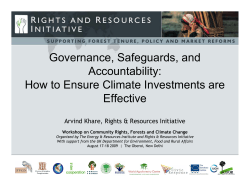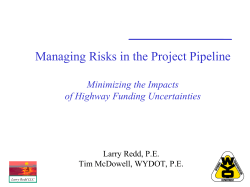
Phase 1
Cost-Benefit Analysis of REDD+ in Lebanon, Morocco and Tunisia Demonstrating REDD+ potential and recognizing importance of non-C co-benefits Liagre, Ludwig; Bouyer, Olivier; Le Crom, Maden; Maurice, Jérôme GIZ-SalvaTerra-GEicO Context A series of CBA studies in the framework of the Regional Project GIZ-CPMF : Adapting forest policy conditions to climate change in Middle East North Africa www.giz-cpmf.org. With the financial support of the Forest Governance Programme (FGP) of the Federal Ministry for Economic Cooperation and Development (BMZ). Technical expertise provided by SalvaTerra. Objectives At the national level, the CBA aimed at : a. developing capacities of national institutions on the REDD+ issues ; b. raising awareness among policy makers from various sectors about the feasibility of REDD+ implementation and related direct and indirect costs and benefits ; c. identifying the cost-efficiency of REDD+ options and highlighting possible priorities for action. At the regional level, the CBA process targeted : a. the identification of common points between CPMF partner countries about the REDD+ options to be implemented ; b. the agreement on key messages regarding direct and indirect costs and benefits, such as the importance of noncarbon benefits (i.e. co-benefits of REDD+). Phase 2 : Implementation of the national REDD+ strategy Costs Studies, consultations, capacity development, institutional arrangements Costs of REDD+ activities and indirect costs (transaction costs, socio-economic costs with restricted access, opportunity costs…) « Fast start » fundings: subvention and grants for the readiness phase + implementation of the strategy Phases Phase 1 : Development of the national REDD+ strategy Benefits Perimeter Phase 3 : Evaluation and Results-based Payments Carbone finance + Goods and services provided by protected Methodology 4 steps 1. Identification of the most promising REDD+ actions (afforestation, grazing management, fires control, etc.). 2. Identification of « Business as usual » and « REDD+ » scenarios for each activity (depending on available funds, technical constraints, etc.). 3. For each scenario, calculation of implementation costs, transaction costs, GHG net emissions and loss/gain of value production by forests (based on pre-existing studies). 4. Costs and benefits calculation, considering direct and indirect costs and benefits (several hypothesis for the value of mitigation/C prices). Selected deforestation and forest degradation drivers REDD+ options are all very significant contributions to Sustainable Forest Management. A REDD+ strategy is a catalyzer for SFM. Key elements of costs and benefits Phase 1 : Costs related to REDD+ strategy design (R-PP; REDD+ strategy) Phase 2 + Phase 3: Direct and Indirect Costs and Benefits of implementing REDD+ options Costs Benefits Direct costs Direct benefits Reinforcing SFM activities (REDD+ options) Result-based payments with more ambitious objectives. 3 prices hypotheses (current C-market price; projected C-market price; tutelary price; ie. 5, 15 and 140 US$/tCO2) Indirect costs Monitoring, Reporting, Verification (MRV) of carbon stocks + E&S impacts monitoring (safeguards)+ Certification. Indirect benefits Non carbon co-benefits: economic valuation of forest ecosystems goods and services. In a nutshell 1) Abatment costs Carbon price (hyp) : 5, 15, 140 US$/tCO2 2) Result-based payments from REDD+ should be considered as very relevant co-financing opportunities for SFM. 3) Integrating non carbon co-benefits in the CBA justifies fully REDD+ investments. Next steps Now that the REDD+ potential is proven, financial resources are needed for the Readiness phase and the design of REDD+ strategies (R-PP, REDD+ strategy) = financing Phase 1 Efforts should focus in particular on : Deepening stakeholder consultations and information sharing to develop and implement the Readiness Preparation Proposal (R-PP); Improving CBA calculation and integrating the whole range of possible REDD+ actions; Updating the forest inventory, in order to refine the assessment of forest degradation and deforestation drivers; Elaborating a BaU baseline and a REDD+ baseline, at sub-national levels and national level; Developing a National System dedicated for monitoring, reporting and verification of GHG emission (MRV system) and REDD+ non carbon co-benefits; Developing an ad hoc framework for Strategic Environmental and Social Assessment (SESA); Fine-tuning institutional arrangements. Potentially interested donors : World Bank (FIP), FCPF, UN-REDD, GEF (SFM/REDD+), Green Climate Fund (GCF), others? Thanks for your attention !!! Download the studies : www.giz-cpmf.org Contacts Reinhard.Kastl@giz.de O.Bouyer@salvaterra.fr M.Le-Crom@salvaterra.fr J.Maurice@salvaterra.fr Ludwig.Liagre@geico-consult.fr Annexes Coût de préparation de la stratégie REDD+ (phase 1) 02.04.2015 Coût de préparation de la stratégie REDD+ (phase 1) Comp 1a 1 b/c Intitulé Organisation institutionnelle pour la phase Préparation Consultations et partage d’information 2a Etat des lieux du secteur forestier 2b Elaboration des stratégies REDD+ 2c Cadre de mise en œuvre 2d Evaluation environnementale et sociale stratégique 3 Scénario de référence 4a Suivi des émissions et absorptions (MRV) 4b Suivi des impacts socio-environnementaux 5 02.04.2015 Suivi et évaluation de la mise en œuvre Coût moyen pour 31 pays : 12,4 M $US Coût pour le Maroc: ~ 10 M $US
© Copyright 2025












